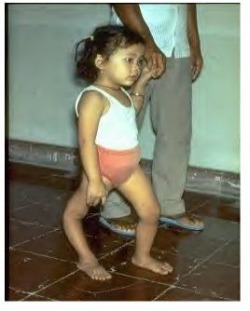Polio
Description Poliomyelitis (polio) is a highly infectious disease caused by a virus that invades the nervous system.
Symptoms Up to 95% of persons infected with polio will have no symptoms. About four to eight percent of infected persons have minor symptoms such as fever, fatigue, nausea, headache, flu-like symptoms, stiffness in the neck and back, and pain in the limbs which often resolves completely. Fewer than one percent of polio cases result in permanent paralysis of the limbs (usually the legs). Of those paralyzed, 5-10% die when the paralysis strikes the respiratory muscles.
Complications Paralysis that can lead to permanent disability and death.
Transmission Contact with an infected person
Vaccine There are two types of vaccine that can prevent polio: inactivated polio vaccine (IPV) and oral polio vaccine (OPV). IPV has been used in the United States since 2000; however OPV is still used throughout much of the world.
Who Needs to be Vaccinated? IPV is a shot, given in the leg or arm, depending on age. Polio vaccine may be given at the same time as other vaccines.
Does my infant or child need this vaccine? UPDATED May 2009 Children should be vaccinated with 4 doses of inactivated polio vaccine (IPV) at the following ages:
Disclaimer: The information contained on the Meningitis Angels web site is not to be considered medical advice or treatment. Consult your health care provider or local health department if you are sick prior and/or prior to the use of any vaccines. Information on this Web site is provided for educational and informational purposes only.
Resource this page www.cdc.gov
Symptoms Up to 95% of persons infected with polio will have no symptoms. About four to eight percent of infected persons have minor symptoms such as fever, fatigue, nausea, headache, flu-like symptoms, stiffness in the neck and back, and pain in the limbs which often resolves completely. Fewer than one percent of polio cases result in permanent paralysis of the limbs (usually the legs). Of those paralyzed, 5-10% die when the paralysis strikes the respiratory muscles.
Complications Paralysis that can lead to permanent disability and death.
Transmission Contact with an infected person
Vaccine There are two types of vaccine that can prevent polio: inactivated polio vaccine (IPV) and oral polio vaccine (OPV). IPV has been used in the United States since 2000; however OPV is still used throughout much of the world.
Who Needs to be Vaccinated? IPV is a shot, given in the leg or arm, depending on age. Polio vaccine may be given at the same time as other vaccines.
Does my infant or child need this vaccine? UPDATED May 2009 Children should be vaccinated with 4 doses of inactivated polio vaccine (IPV) at the following ages:
- A dose at 2 months
- A dose at 4 months
- A dose at 6-18 months
- A booster dose at 4-6 years
- You are traveling to polio-endemic or high-risk areas of the world. Ask your healthcare provider for specific information on whether you need to be vaccinated.
- You are working in a laboratory and handling specimens that might contain polioviruses.
- You are a healthcare worker treating patients who could have polio or have close contact with a person who could be infected with poliovirus.
- The first dose at any time,
- The second dose 1 to 2 months later,
- The third dose 6 to 12 months after the second.
Disclaimer: The information contained on the Meningitis Angels web site is not to be considered medical advice or treatment. Consult your health care provider or local health department if you are sick prior and/or prior to the use of any vaccines. Information on this Web site is provided for educational and informational purposes only.
Resource this page www.cdc.gov
